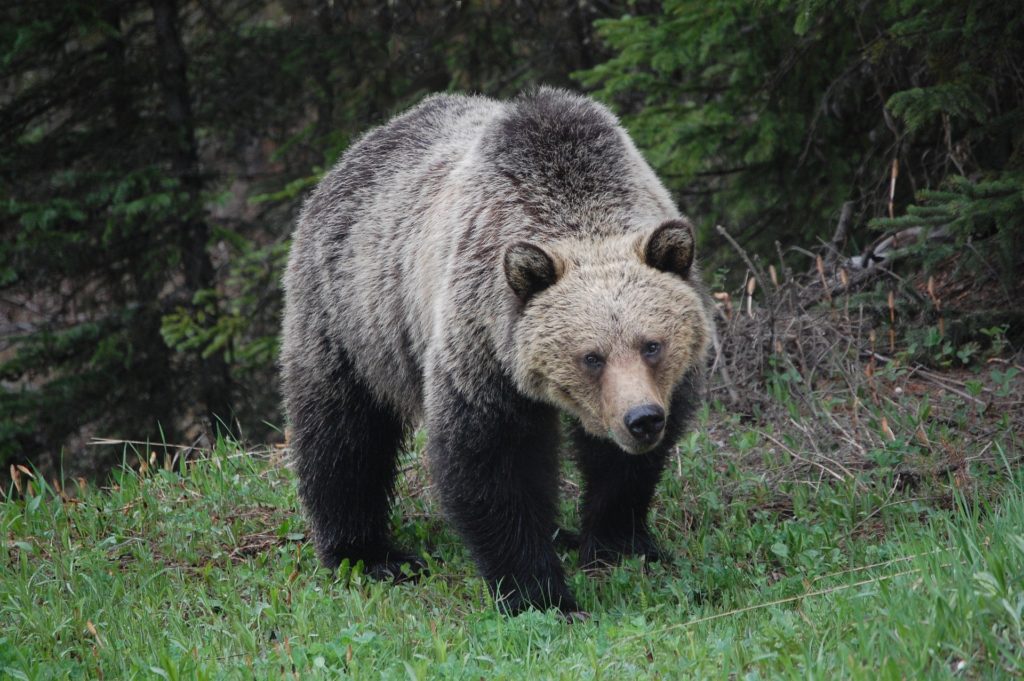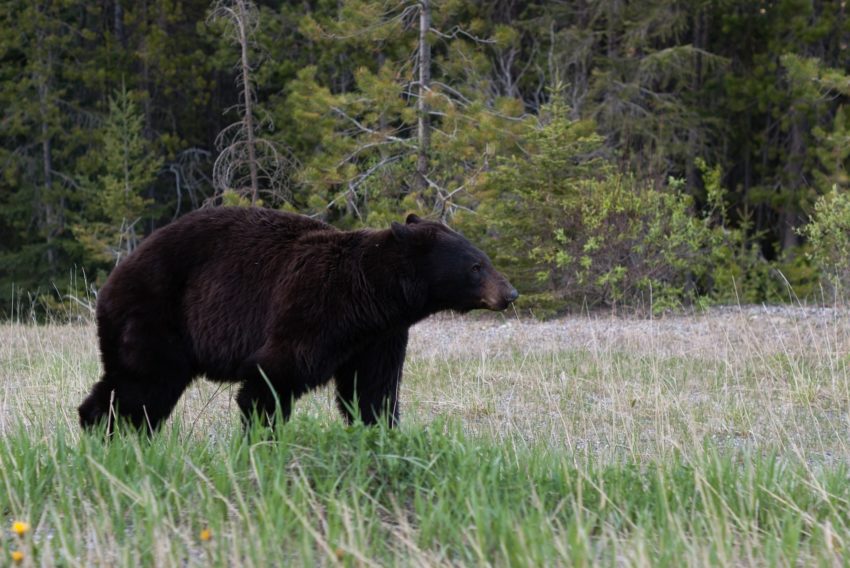I’ve grown up enjoy hiking, but always with the appreciation that bears and cougars may be enjoying the same hiking area. When I was young, my dad always use to tell us many fun stories of bear encounters when he spent a couple summers working on the forestry service. He and a couple guys would get helicoptered in somewhere for a week for forestry work.
To be honest I can’t really even remember what he was doing in the woods, as a kid I was far more interested in the bear stories. I grew up with a sense that you just needed to be loud in the woods and black bears would stay clear of you, and that really they were just curious.
I remember one story where him and a buddy ran into a bear and decided to climb trees to avoid the bear. In this case it really didn’t work. As both of the guys were up different trees, the bear went to the base of my dads tree and was not happy. It wasn’t until the other guy noticed that their was a cub above my dad on the same tree!

The story went that both my dad and the cub climb further up the tree, until my dad got up to the cub, gently tapped it on his head and the cub beelined in down the tree. The mother bear had a quick inspection of the cub and then they both went off on their merry way.
I only recall one story where they stumbled on to the edge of the forest and saw a number of grizzly bears off in the distance. I grew up with a sense that as long as your bear aware, you’re probably fine.
Grizzly Bears are the same as Black Bears and they will try to avoid people as well. The majority of Grizzly Bear attacks happen when you surprise them. Bears, and it seems especially Grizzly Bears do not like surprises.

Bear encounters are rare, but it’s good to know what to do if you’re on the wrong end of the statistics one day and run into a bear. Black bears are throughout the Southern Gulf Islands, Vancouver Island, and further north. There is also a viable Grizzly Bear population in parts of Desolation Sound and further north.
Bears are fantastic swimmers, allowing them to also move from island to island via swimming. While Vancouver Island has historically only be known to have black bears, over the last couple of years grizzly bear sightings have been on the rise. In May of this year, there were at least 7 grizzly bears spotted in the Sayward area!
The combination of knowing that BC has black bears, a viable grizzly bear population around Desolation Sound and into the Broughton Archipelago’s bear boater safety is important. Plus, the little fact that bears are great swimmers and Grizzly bears sightings are on the rise on Vancouver Island!
Over the years there’s been a couple of times that I’ve been on edge that a bear was possibly in the area. I remember a time we were up Frederick Arm, where there were no sightings, but knowing a Grizzly Bear had been spotted in the area early that week I was on high alert. It was a great spot to anchor, but I was very aware there no no other boats in sight, and there was a very well worn path coming down from the hill to the shore by our anchorage, and it was not a human hiking trail.
I had another uncomfortable experience on Reid Island. I was once told that Reid Island is on the animal highway. I have no idea if there’s any truth to it, but I remember hiking with two other people and a dog through a brush area, being at the end of the hiking line and hearing a very loud exhale. We were out of the brush in no time and onto another section of the trail, but I will never forget the sound I heard.
While tips are good, I will also say that always go with your inner spidy sense. If you’re out hiking somewhere and have a bad feeling but no visual to support, go with your gut. We were hiking an old logging road once up in the Broughton Archipelago’s once and as we were approaching the crest of a hill, we both were starting to get uncomfortable. I have no idea what, if anything was over the hill of the logging road, but I don’t for a second regret going with our gut.
Hiking in the great outdoors is great, it’s just important to appreciate that we share our outdoor playground. Both Black Bears and Grizzly Bears can be very kind animals, they just really don’t like surprises.
Here’s some tips help to reduce your risk of something happening, there’s no guarantee by following the tips that you’ll be safe. Playing in our great outdoor playground that is shared with bears, all we can do is do what we can to reduce the risks of problems.
Tips to Avoid a Bear Encounter
- Do not surprise a bear! Be loud as you’re walking. Bear bells can help, but the human voice carries much better. Talk , whistle or sing as you walk to help let a bear know you’re in the area. Be extra loud when hiking near water. Running water and water falls can make it harder for a bear to hear you above the water noise.
- Hike in numbers. Hike in a group. Bears will avoid you if they hear you, and bear attacks when hiking in a group are far less likely than solo.
- Be alert for signs of a bear. Watch for bear scat, tracks, torn up trees or torn up logs. If you see signs of a bear, consider turning around and going for the day hike another day.
- Dog Safety. Keep dogs on a leash. Dogs can run run off the path in hot pursuit of something, which can lead to infuriating the bear and inciting an attack. Dogs should be kept on a leash when hiking for both their safety and yours.
- Watch for cubs. You don’t want to get between a mother bear and her cubs. Keep clear of cubs.
- Caution While Hiking Around Bear Food. Wild orchards, berries and dead animals are all food sources for bears. Be cautious when you’re passing these types of areas.
- Hike During the Day. Avoid hiking during both sunrise and sunset.
What to Do if You See a Bear
- Know your Bears. Know what a Black Bears and Grizzly Bears look like. If you encounter a bear, being able to identify what kind of bear it is will better equip you for your next move.
- Stay Calm. You need to stay calm and strategize your exit.
- Do Not Run. Bears can outrun you, and running may trigger them to attack. Back away slowly at an oblique angle, bears consider sideway movements non-threatening.
- Talk to the Bear Softly. Talk to the bear in a monotone voice. Do not yell at the bear, do not turn your back on it, and
- Do not make eye contact.
- Do Not Try to Distract the Bear. Do not try to throw food, clothes or objects to try to distract the bear.
- Give the Bear Space. Leave the area, make a wide detour, do what you can to keep out of the bears way. You may be on his path to his berry patch or some kind of food source, or maybe cubs. Do what you can do give the bear space. If a bear stands on it’s hind legs, that’s not a sign of aggression. The bear may be trying to pick up your scent.
- Watch for Signs the Bear is Stressed. Black Bears can display signs of aggression when stressed. Swatting at the ground, vocalizing such as huffs and moans. Give the bear space.
If an Attack Occurs
Defensive Attack
- If a bear is being defensive, food or its cubs, physical contact has either been made or is impenitent, lie on your stomach with your legs apart, hands over the back of your neck and play dead. Use your elbows and toes to prevent the bear from rolling you over. If you do roll over, keep rolling over so you land back on your stomach.
- Do not drop down until the bear is practically over you. Laying down early will cause the bear to be curious and come towards you.
- Defensive Black Bears and Grizzly Bears will leave once they believe the threat is gone.
Offensive Attack
- If a bear is being offensive, playing dead isn’t going to work. An offensive attack is when a bear has been stalking you, getting ready to attack. If you’re not able to evacuate the area, you need to act aggressively and try to intimidate the bear.
- If you have bear spray you can attempt to spray their eyes if they get close. Bear spray isn’t a sure way to deter a bear, it’s just one of the things you can do to try to intimidate the bear.
Further Reading Resources
Here’s some links for learning more about bears in BC:
